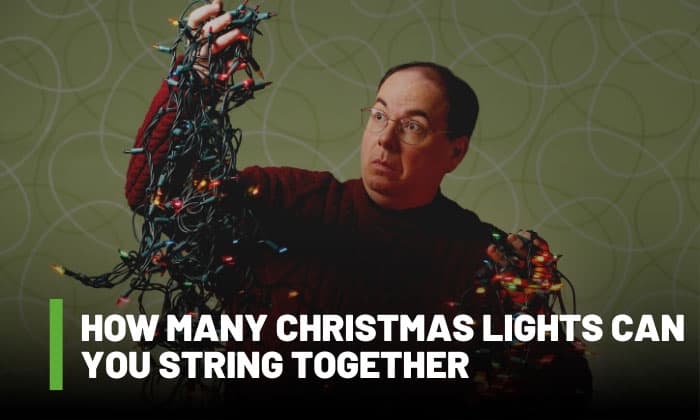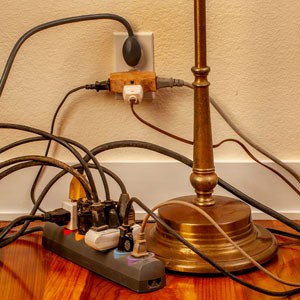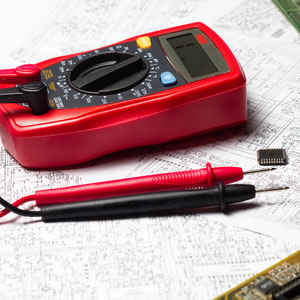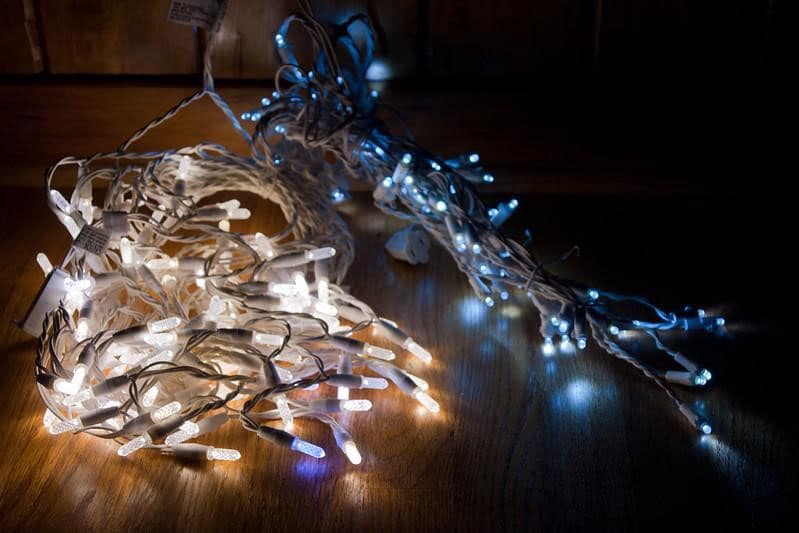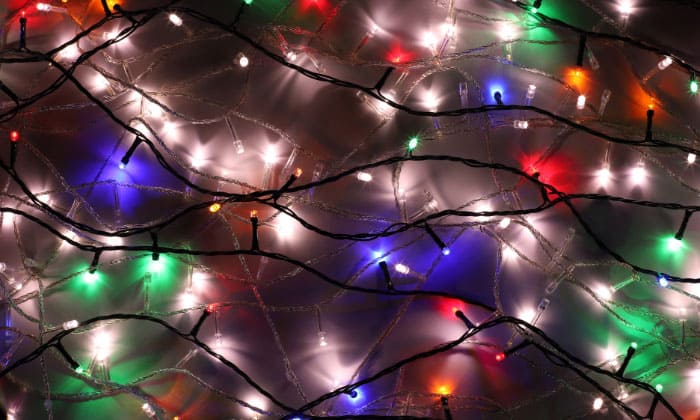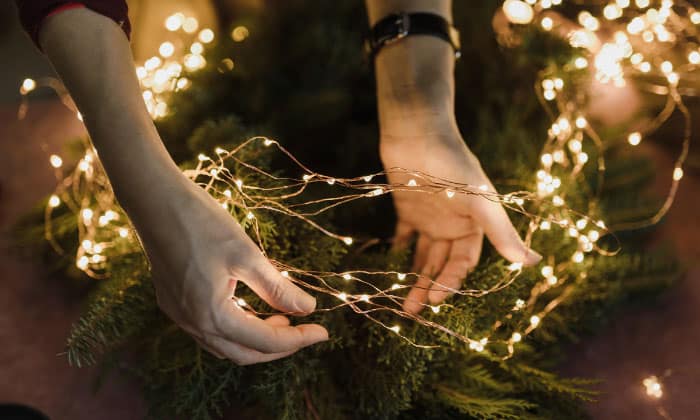Every time the holidays draw near, I tend to receive many questions regarding new appliances and fixtures, but none more so than those about Xmas lights. “How many Christmas lights can you string together?” is one of the more popular ones for obvious reasons.
UL guidelines used to advise only to limit it to three strands, and that’s still fairly safe and reliable. However, nowadays, you can use more than 10, even up to 50 light strands with LED lights.
Read on to determine the exact limit in your setup by factoring in the total wattage of each strand, your circuit’s capacity, and the lights’ wire gauge.
There are other elements and steps you need to consider to hang Xmas indoor and outdoor lights, though, so do continue reading.
Table of Contents
How Many Christmas Lights Can You Really Safely Combine?
Let’s first look at how the various factors influence how you can correctly (or wrongly) connect multiple Christmas lights together:
1. Total Wattage of Each Strand
You need to account for the total wattage of each strand and then add their total. Afterward, you need to calculate their total amperage to make sure that it won’t exceed the circuit’s capacity AND will still be appropriate for the lights’ wire gauge.
2. Circuit’s Capacity
Related to the point above, the entire lighting setup’s electrical current shouldn’t exceed the circuit’s limit. Ideally, when you mix Christmas lights, they have to have a dedicated circuit.
For example, assuming you have 150 watts for each strand, you can determine the number of lights you can combine by simply adding their total and looking at your circuit while making sure you only use up to 80% of its capacity, as per NEC guidelines.
Let’s say it’s being protected by a 30A breaker or fuse. That leaves us with a 2400W total, but obviously, we can only use up to 1920W.
1920W / 150W = 12.8
That means you can only use up to 12 strands at most since that’s a total of 1800W. If we go for 13, that already sends us over the limit since that’s 1950W.
But that’s just one checkmark you need to get, as you also have to pay attention to the wire gauge.
3. The Lights’ Wire Gauge
Did you know that the UL guideline isn’t only concerned with wattage when it says you should be wary if you want to connect more than 3 strands of lights? This is because some lights have small wire gauges.
Just think about it, is it really safe to connect multiple lights that all have 22-gauge wire? Of course not! They’ll be overloaded in no time!
This is why you may want to consider getting an 18-gauge wire (which can handle between 14A to 18A) instead of a 22-gauge one (which is limited to a 7A ceiling).
So even if you do have 1920W as the limit in the above scenario, you may have to limit it further to just 1680W since that’s what it can only handle at 120V.
1680W / 150W = 11.2
That means the true number of strands you can safely string together in the same circuit or per outlet is 11.
Understandably, the main question can still be a source of confusion since some factors tend to be overlooked. Other than the three I said above these are the other ones that can influence the answer to how strings of lights can you put together:
4. Christmas Light Type
In most cases, you’ll only be able to combine a few strands of incandescent icicle lights compared to most LED Christmas lights. The latter have naturally lower wattages, after all.
Each one inevitably has its pros and cons. Incandescent lights are still the more budget-friendly choice, but they just eat up more power.
Many Reddit users are loving LED lights more since not only can you string hundreds of these together, but they barely add to your total power bill as well! They do cost more initially, though.
5. Your Electrical Service’s Capacity
Don’t forget that how many strings of lights can you plug together can also be influenced by your property’s specific electrical service. Always check your electrical service’s capacity first!
Services with lower voltages tend to be less efficient and lead to higher total wattages, and the calculations made here only prove this. And, yes, that means even if your circuit can realistically handle 12 strands of incandescent Christmas lights, you still have to limit them to suit your service’s capacity.
Either that or be more careful with the type of lights you choose and favor strands with lower wattages in general.
Tips to Calculate the Number of Lights for Your House
Once you know the exact Here’s a rundown of all the calculations I made above and I hope you’ll remember every time you’re faced with this challenge:
- To calculate the total strands you can put in a single circuit:
Total Circuit Capacity (with 80% rule included) / Wattage Per String = Maximum Strands You Can Combine
- To factor in the lights’ wire gauge:
Wire Gauge Wattage Capacity / Wattage Per String = Safest Number of Strands You Can Combine
- Adhere to local code regulations
Of course, I can’t just be looking at the technical stuff when determining how many strands of Christmas lights can I connect. I also need to know whether there are set limits to the number of lights you can mix, and I suggest you do the same.
Moreover, don’t overlook the laws set by the local fire department when doing your research. In California, for example, you actually can’t go past the three-strand limit when using an extension cord.
They may also limit the watts to a certain small figure (e.g. 210W) for the entire run, which could mean you’ll realistically only be able to string together 10 or even less.
Benefits of Christmas Lights
People can’t help but connect outdoor string lights together once Christmas comes around, and this has been the case since they entered the holiday scene. Incidentally, do you know who invented the first Christmas lights?
As for why folks can’t help but put these fairy lights up once the Yuletide season rolls in, it’s safe to say that they’re more than just eye candy. These benefits prove as much:
- They set that inimitable tone of the Christmas season. Who among us doesn’t get immediately festive and cheerful once we behold these sparkling and blinking lights?
- Using LED lights can help you save on your electricity bill, especially as you won’t need to turn on outdoor lights if they’re running. Not to mention that they’re highly environment-friendly, too.
- Set up correctly, they can easily raise your home’s aesthetics, especially during the winter months, when we can all use a break from the monotonous colors.
Frequently Asked Questions
What happens if you string too many Christmas lights together?
Every strand tends to come with its own fuse. Once you overload it (i.e. connect way too many strings together), the fuse will blow to protect the lights from the potential damage that the surge can inflict on them.
On the off-chance that they don’t have a fuse, you better be scared as they can cause a fire, just like any circuit that isn’t protected.
How many 100 Christmas lights can I connect together?
This depends on the total watts of each strand as well as its wire gauge and how they suit your intended circuit’s capacity.
For instance, if you have 5W for each 100-light LED strand and their cord is rated at 16 AWG, you’ll only have 1200W in total to work with.
1200W / 5W = 240 strands
Heed the tips and calculations I made above to make your life easier.
How many LED lights can I run?
If you use LED lights, you can literally combine 40 to more than 50 Christmas lights with only one plug (i.e. outlet without blowing a fuse!
Make sure you consider the safety limit, but generally, LED lights with a hundred lights per string have a total of just 7 watts.
Conclusion
I hope this has resolved every issue related to Christmas tree lights, and you can now go full Griswold and savor the holidays with your loved ones. Again, as far as how many Christmas lights can you string together goes, always dive into the details of your particular setup.
Know the type of light you’re going to buy, calculate total wattage and amperage, and make sure they’re suitable for your circuit’s and service’s capacity and the wire gauge of the lights. It’s not rocket science if you know which variables and factors to look at.

I am Edwin Jones, in charge of designing content for Galvinpower. I aspire to use my experiences in marketing to create reliable and necessary information to help our readers. It has been fun to work with Andrew and apply his incredible knowledge to our content.

